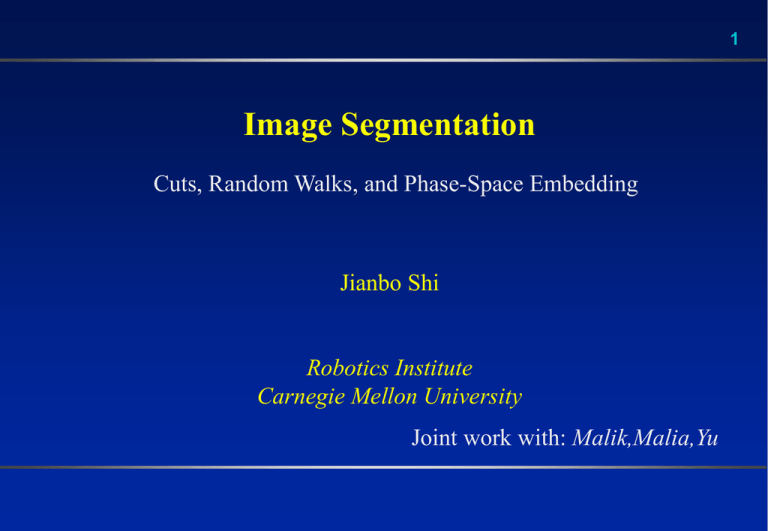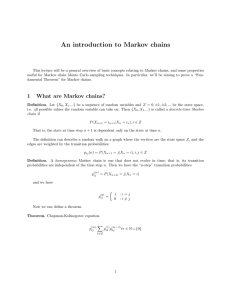JShi_ncut_talk - Oxford Brookes University
advertisement

1
Image Segmentation
Cuts, Random Walks, and Phase-Space Embedding
Jianbo Shi
Robotics Institute
Carnegie Mellon University
Joint work with: Malik,Malia,Yu
Taxonomy of Vision Problems
Reconstruction:
– estimate parameters of external 3D world.
Visual Control:
– visually guided locomotion and manipulation.
Segmentation:
– partition I(x,y,t) into subsets of separate objects.
Recognition:
– classes: face vs. non-face,
– activities: gesture, expression.
2
3
We see Objects
4
Outline
Problem formulation
Normalized Cut criterion & algorithm
The Markov random walks view of Normalized Cut
Combining pair-wise attraction & repulsion
Conclusions
5
Edge-based image segmentation
Edge detection by gradient operators
Linking by dynamic programming, voting, relaxation, …
Montanari 71, Parent&Zucker 89, Guy&Medioni 96, Shaashua&Ullman 88
Williams&Jacobs 95, Geiger&Kumaran 96, Heitger&von der Heydt 93
-
Natural for encoding curvilinear grouping
Hard decisions often made prematurely
6
Region-based image segmentation
Region growing, split-and-merge, etc...
- Regions provide closure for free, however,
approaches are ad-hoc.
Global criterion for image segmentation
• Markov Random Fields e.g. Geman&Geman 84
• Variational approaches e.g. Mumford&Shah 89
• Expectation-Maximization e.g. Ayer&Sawhney 95, Weiss 97
- Global method, but computational complexity precludes exact MAP
estimation
- Problems due to local minima
7
8
Bottom line:
It is hard, nothing worked well, use edge
detection, or just avoid it.
Global good, local bad.
9
Global decision good, local bad
– Formulate as hierarchical graph partitioning
Efficient computation
– Draw on ideas from spectral graph theory to define an
eigenvalue problem which can be solved for finding
segmentation.
Develop suitable encoding of visual cues in terms
of graph weights.
Shi&Malik,97
Image segmentation by pairwise similarities
Image = { pixels }
Segmentation = partition of
image into segments
Similarity between pixels i
and j
Sij = Sji 0
Sij
Objective: “similar pixels should be in the same
segment, dissimilar pixels should be in different
segments”
10
Segmentation as weighted graph partitioning
Pixels i I = vertices of graph G
Edges ij = pixel pairs with Sij > 0
Similarity matrix S = [ Sij ]
is generalized adjacency matrix
di = Sj Sij
i
i
degree of i
vol A = SiA di volume of A I
A
Sij
11
j
Cuts in a graph
(edge) cut = set of edges whose removal makes a
graph disconnected
weight of a cut
cut( A, B ) = Si A,j B Sij
the normalized cut
1 .
1 .
NCut( A,B ) = cut( A,B )(vol A + vol B )
12
Normalized Cut and Normalized Association
Ncut (A, B)
cut (A, B) cut (A, B)
Vol(A)
Vol ( B)
assoc(A,A) assoc (B, B)
Nassoc(A, B)
Vol(A)
Vol ( B)
Ncut (A, B) 2 Nassoc (A, B)
Minimizing similarity between the groups, and maximizing similarity
within the groups can be achieved simultaneously.
13
The Normalized Cut (NCut) criterion
Criterion
min NCut( A,A )
Small cut between subsets of ~ balanced grouping
NP-Hard!
14
Some definitions
15
Let W be the associatio n matrix, W (i, j ) wi , j ;
Let D be the diag. matrix, D(i, i ) j W (i, j );
Let x be a vector in {1,1}N , x(i ) 1 i A.
Normalized Cut As Generalized Eigenvalue problem
Rewriting Normalized Cut in matrix form:
Ncut (A, B)
cut (A, B) cut (A, B)
Vol (A)
Vol (B)
(1 x)T ( D W )(1 x) (1 x)T ( D W )(1 x)
; k
T
T
k1 D1
(1 k )1 D1
...
D(i, i)
D(i, i)
xi 0
i
16
More math…
17
Normalized Cut As Generalized Eigenvalue problem
Ncut (A, B)
18
cut (A, B) cut (A, B)
Vol (A)
Vol (B)
D(i, i )
(1 x)T ( D W )(1 x) (1 x)T ( D W )(1 x)
xi 0
; k
T
T
k1 D1
(1 k )1 D1
i D(i, i)
...
after simplification, we get
yT ( D W ) y
T
Ncut ( A, B)
,
with
y
{
1
,
b
},
y
D1 0.
i
T
y Dy
y2i
A
i
( D W ) x Dx
y2i
A
i
Interpretation as a Dynamical System
19
Interpretation as a Dynamical System
20
Brightness Image Segmentation
21
brightness image segmentation
22
Results on color segmentation
23
Malik,Belongie,Shi,Leung,99
24
25
Motion Segmentation with Normalized Cuts
Networks of spatial-temporal connections:
26
Results
27
Results
Shi&Malik,98
28
Results
29
Results
30
Stereoscopic data
31
Conclusion I
Global is good, local is bad
– Formulated Ncut grouping criterion
– Efficient Ncut algorithm using generalized eigen-system
Local pair-wise allows easy encoding and combining
of Gestalt grouping cues
32
Goals of this work
33
Better understand why spectral segmentation works
– random walks view for NCut algorithm
– complete characterization of the “ideal” case
ideal case is more realistic/general than previously thought
Learning feature combination/object shape model
– Max cross-entropy method for learning
Malia&Shi,00
The random walks view
Construct the matrix
d1
D=
d2
...
P = D-1S
S =
dn
S11 S12 S1n
S21 S22 S2n
...
Sn1 Sn2 Snn
P is stochastic matrix Sj Pij = 1
P is transition matrix of Markov chain with state space I
p=
1 . [ d d . . . d ]T is stationary distribution
1 2
n
vol I
34
Reinterpreting the NCut criterion
NCut( A, A ) = PAA + PAA
PAB = Pr[ A --> B | A ] under P, p
NCut looks for sets that “trap” the random walk
Related to Cheeger constant, conductivity in Markov
chains
35
Reinterpreting the NCut algorithm
(D-W)y = mDy
m1=0 m2
y1
y2
...
mn
...
Yn
Px =
1=1 2
x1
mk
x2
36
x
...
...
n
xn
= 1 - k
yk = xk
The NCut algorithm segments based on the second largest eigenvector of P
So far...
We showed that the NCut criterion & its approximation the
NCut algorithm have simple interpretations in the Markov
chain framework
– criterion - finds “almost ergodic” sets
– algorithm - uses x2 to segment
Now:
Will use Markov chain view to show when the NCut
algorithm is exact, i.e. when P has K piecewise constant
eigenvectors
37
Piecewise constant eigenvectors: Examples
Block diagonal P (and S)
S
P
Eigenvalues
Equal rows in each block
Eigenvalues
Eigenvectors
Eigenvectors
38
Piecewise constant eigenvectors: general case
Theorem[Meila&Shi] Let P = D-1S with D non-
singular and let D be a partition of I. Then P has K
piecewise constant eigenvectors w.r.t D iff P is
block stochastic w.r.t D and P non-singular.
Eigenvectors
P
Eigenvalues
39
Block stochastic matrices
D = ( A1, A2, . . . AK )
partition of I
P is block stochastic w.r.t D
SjAs Pij = SjAs Pi’j
for i,i’ in same segment As’
Intuitively: Markov chain can be aggregated so that
random walk over D is Markov
P = transition matrix of Markov chain over D
40
Learning image segmentation
Image
fijq
41
Learning
Model
normalize
Sij
Pij
Pij*
Segmentation
Targets Pij* =
0,
1 .
00,
|A|
A
j A
j
for i in segment A
Model Sij = exp( Sq qfqij )
The objective function
42
J = - Si I 1 .Sj I Pij* log Pij
|I|
J = KL( P* || P )
where p0 = 1 .and Pi j* = p0 Pij* the flow i j
|I|
Max entropy formulation maxPij H( j | i )
s.t. <fijq>p0Pij = <fijq>
Convex problem with convex constraints
J
The gradient
q
= <fijq>
p0Pij*
for all q
at most one optimum
q>
<f
ij
p0Pij *
p0Pij
Experiments - the features
43
i
IC - intervening contour
k
fijIC = max Edge( k )
k
Edge( k ) = output of edge filter for pixel k
Discourages transitions across edges
CL - colinearity/cocircularity
fijCL =
j
(i,j)
2-cos(2ai)-cos(2aj)
1 - cos(al)
+
Edgeness
2-cos(2ai + aj)
1 - cos(a0)
Encourages transitions along flow lines
Random features
orientation
ai
i
j
aj
Training examples
IC
44
CL
Test examples
Original Image
Edge Map
45
Segmentation
Conclusions
46
Showed that the NCut segmentation method has a probabilistic interpretation
Graph Cuts
Generalized Eigen-system
Markov Random Walks
Introduced
– a principled method for combining features in image segmentation
– supervised learning and synthetic data to find the optimal combination of
features

